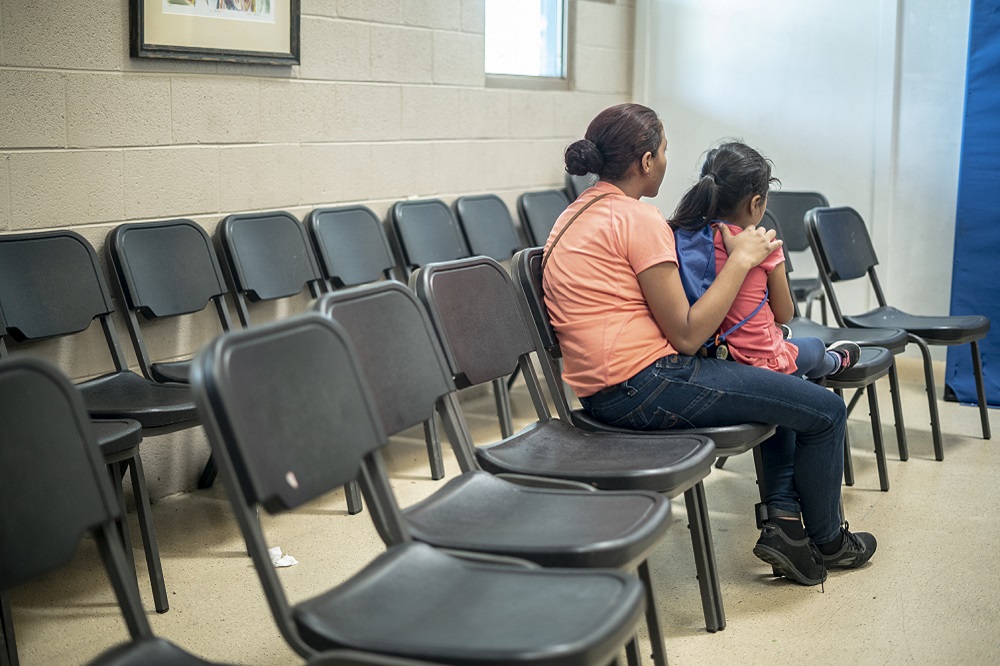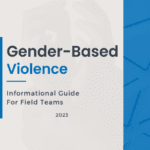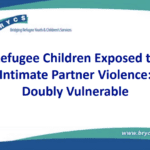Photo: IRC/A. Oberstadt
Humanitarian crises that cause forced migration and displacement often result in people being in less secure and unfamiliar environments. They may be separated from protective family systems and may struggle to meet basic needs. It is common for people to feel things like overwhelm, worry, sadness, confusion, and anger. All of these factors lead to conditions where people may be dependent or partially dependent on systems, agencies, or other individuals to meet their needs, increasing the risk of abuse, exploitation, or harassment. When it comes to preserving safety for both clients and staff, there are many terms you might hear. This blog post reviews two key terms, safeguarding and protection, that relate to service providers’ roles in ensuring the safety of clients and staff.
What is Safeguarding?
Safeguarding refers to actions that seek to increase client and staff safety in the context of work-related interactions. It includes the actions that agencies and workers take to:
- ensure that clients and potential clients are safe from abuse, exploitation and harassment from workers, volunteers, donors, or others they encounter in the context of programs and services;
- identify, report, and address cases of suspected abuse, exploitation, and harassment in an appropriate and timely manner; and
- protect workers from abuse, exploitation, and harassment from colleagues, clients, or others they encounter in their work.
Examples of Safeguarding Concerns
- A staff member pursuing or engaging in a romantic relationship with a client
- A staff member requesting payment from a client for services which should be free
- A client sexually harassing a staff member
In short, safeguarding sets out deliberate actions to ensure the safety and dignity of clients receiving services, and of the workers delivering them.
What is Protection?
Protection denotes actions that seek to increase the safety and security of clients. The key difference between safeguarding and protection is that safeguarding refers to preserving staff and client safety in the context of the work-related interactions, while protection includes preserving client safety in other contexts, including interpersonal and domestic violence, child abuse and neglect concerns, and trafficking concerns.
Examples of Protection Concerns
- A client being involved in a physically or emotionally abusive relationship with another member of the client population
- A minor client disclosing that an adult at local public school has touched them inappropriately
- An elderly and disabled client being coerced by a relative to turn over their disability insurance checks to the relative
How Do They Fit Together?
Safeguarding and protection often overlap with each other, given that any type of abuse, exploitation, or harassment of a client can be both a safeguarding and protection issue, depending on who is the perpetrator of the incident.

How Can I Promote Safeguarding and Protection in My Work?
Below are a few steps that agencies and individuals can take to increase protective factors and reduce risk factors as they relate to safeguarding and protection. Recommended resources are also provided.
- Establish safeguarding policies: Have specific policies related to safeguarding, including an established way to investigate safeguarding concerns and a “no retaliation” policy for those who raise a concern. These policies should cover anyone who may interact with a client or potential client, including employees, volunteers, interns, contractors, consultants, board members, and more. Have onboarding processes that ensure that all workers understand the safeguarding policies and regularly review these policies with workers. Provide training on safeguarding annually to all staff, to reinforce positive messaging and create a culture of deterrence.
- Bond Template: Safeguarding Policy
- Action Against Hunger Toolkit: Preventing Sexual Exploitation and Abuse (PSEA) in the Employee Lifecycle
- Trickle Up Guide: Low and No Cost Safeguarding Measures for Small Nonprofits: A Manual
- Thrive Worldwide Tip Sheet: Psychosocial considerations for managers supporting staff after a critical incident
- Make it clear how to report concerns: Offer multiple channels for reporting safeguarding concerns, including an anonymous channel. Consider using a survivor-centered approach to reporting safeguarding violations against adults (this approach emphasizes the safety, welfare, and rights of the survivor before all other considerations, meaning that if an adult survivor does not wish to report a violation, this wish is respected). Educate all new staff and clients on how they can report a concern. Post signs about safeguarding in multiple languages with appropriate visuals to educate clients.
- Bond Tip Sheet: Dealing with Safeguarding Reports
- Interaction Tool: Investigation Planning
- Support staff outside the office: Have procedures in place that mitigate risk when staff are working out of the office. For example, under what circumstances should home visits be allowed/not allowed? How do other staff know where they are if there is a concern? What sort of device(s) should staff carry to reach out in an emergency?
- Switchboard Checklist: Safety During Client Home Visits
- Establish protection policies: Have specific policies related to protection. Map protection support services and resources in your local area (e.g., crisis response support, domestic violence shelters and hotlines, etc.). Post signage around the office in multiple languages that address protection issues and how to reach out for help. Ensure that all staff can recognize a crisis or emergency and know how to respond.
- Switchboard Information Guide: Fundamentals of Gender-Based Violence (GBV) for Refugee Service Providers: What Does a Culturally Responsive Approach Mean?
- Switchboard Information Guide: Fundamentals of Gender-Based Violence (GBV) for Refugee Service Providers: The What, Why, and How of Safety Planning
- Educate clients on U.S. laws: In cultural orientation, and in other program contexts, take steps to ensure clients fully understand U.S. laws that relate to safety and protection.
- IRC Pamphlet: Understand Your Rights & Responsibilities in the United States. Available in English, Dari and Pashto
- USAHello Multilingual Web Pages: Most important U.S laws to know (includes a section on “Marriage, sex, and incest” as well as “Fighting and violence”); Understanding American cultural differences and views (includes sections on “Marriage and divorce,” “Family,” and “Women and girls”); Raising children and parenting laws in the United States
- Cultural Orientation Resource Exchange (CORE) Lesson Plan and Materials, U.S. Laws
- Emphasize client rights and responsibilities: Have established client rights and responsibilities that explain what is expected of them in services, considerations for safeguarding, and where clients can report issues of concern. Educate all new clients on their rights and responsibilities.
- Switchboard Information Guide: Discussing Rights and Responsibilities
- Switchboard Template: Rights and Responsibilities Policy









